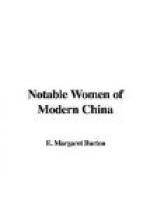As the fame of the young physicians grew and their practice steadily increased, they found themselves greatly hampered by lack of a proper building in which to carry on their work. In 1898 Dr. Stone wrote back to America: “Our tiny hospital is crammed full. An observer might think that we carried home but a slight idea of hygiene. Our hospital measures on the outside 28 by 21 at Chinese feet (our foot is one inch longer than yours) and we have been compelled to crowd in twenty-one sleepers. The building being so small and not protected from the heat of the sun by any trees or awnings, by evenings it is fairly an oven, which is certainly not a very desirable place for sick people. We are looking forward all the time for signs or signals from the women of America to build our new hospital, but not a letter comes to bring us this kind of message. Still we are thankful for the hope of building some time.”
This hope was realized almost at once, largely through the generosity of the friend Dr. Stone had made in Chicago, Dr. I. N. Danforth, who felt that no more fitting memorial could be erected to his wife than a hospital for Chinese women and children. Dr. Stone and Dr. Kahn drew their own plans and sent them to Chicago, where they were perfected in every detail by an architect of that city, and sent back to Kiukiang with the necessary specifications and instructions. These plans were carried out to the letter and in 1900 an airy, grey brick building, finished with white granite and limestone, plentifully supplied with comfortable verandas, and bearing over its pillared entrance the name, “Elizabeth Skelton Danforth Memorial Hospital,” was ready for occupancy. But on the very day that the furniture was moved in, the American consul advised all foreign women and children to leave Kiukiang immediately. The other missionaries were so unwilling to leave the young doctors to face the possible dangers from the Boxers alone, that they finally prevailed upon them to go to Japan with them.
The hospital escaped any injury, however, and in her report for 1900, Dr. Stone said: “Our new hospital is a comfort and constant inspiration to us in our work. We were indeed grateful, after half a year’s enforced exile, to come home and find it intact and ready for use.... During six months there have been 3,679 dispensary patients, 59 in-patients, and 414 visits.”
[Illustration: Elizabeth Skelton Danforth Memorial Hospital, Kiukiang, China]
The hospital was formally opened on the seventh of December, 1901, during the annual meeting of the Central China Methodist Mission, held that year at Kiukiang. The North China Daily Herald gives the following account of this interesting occasion:




